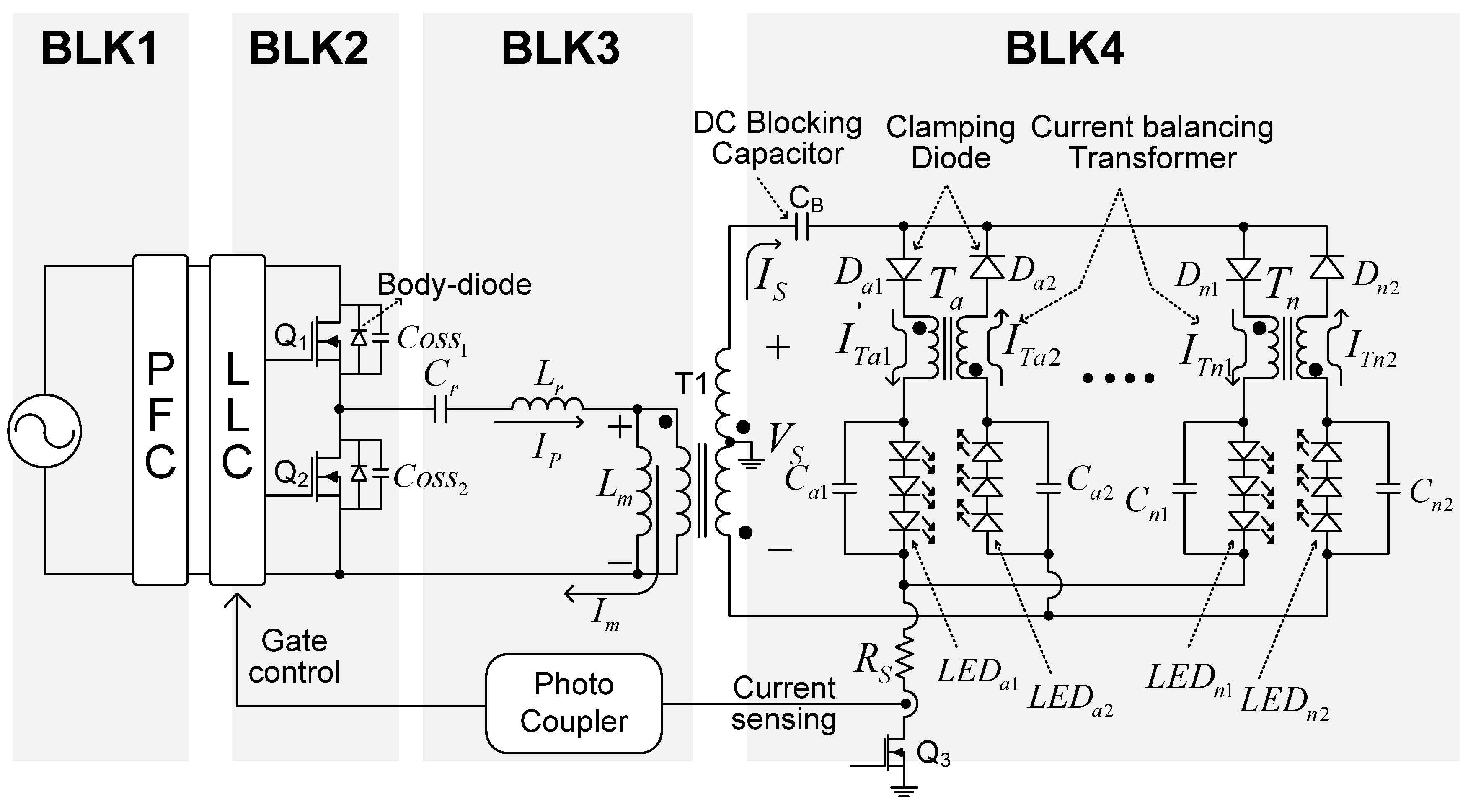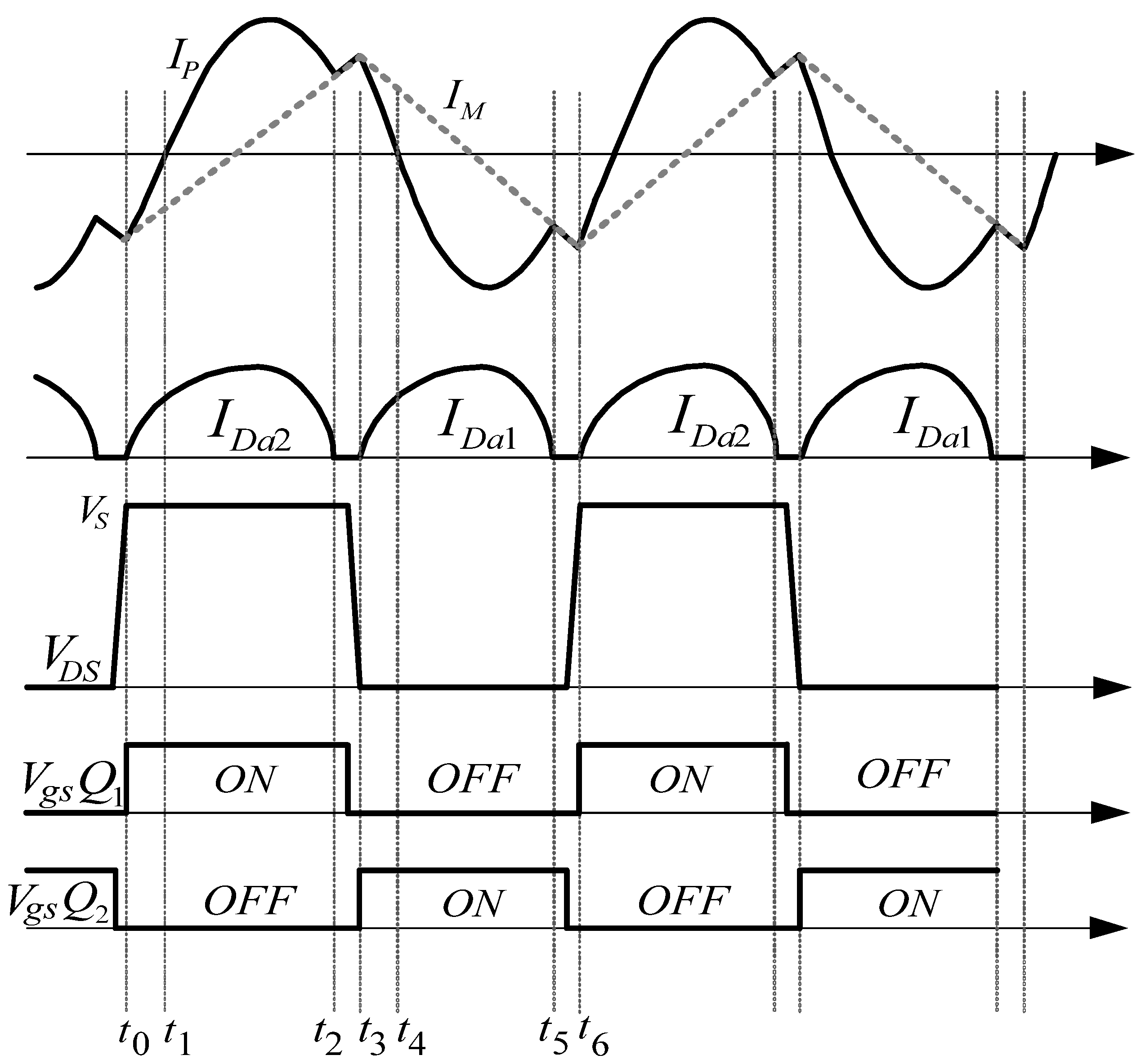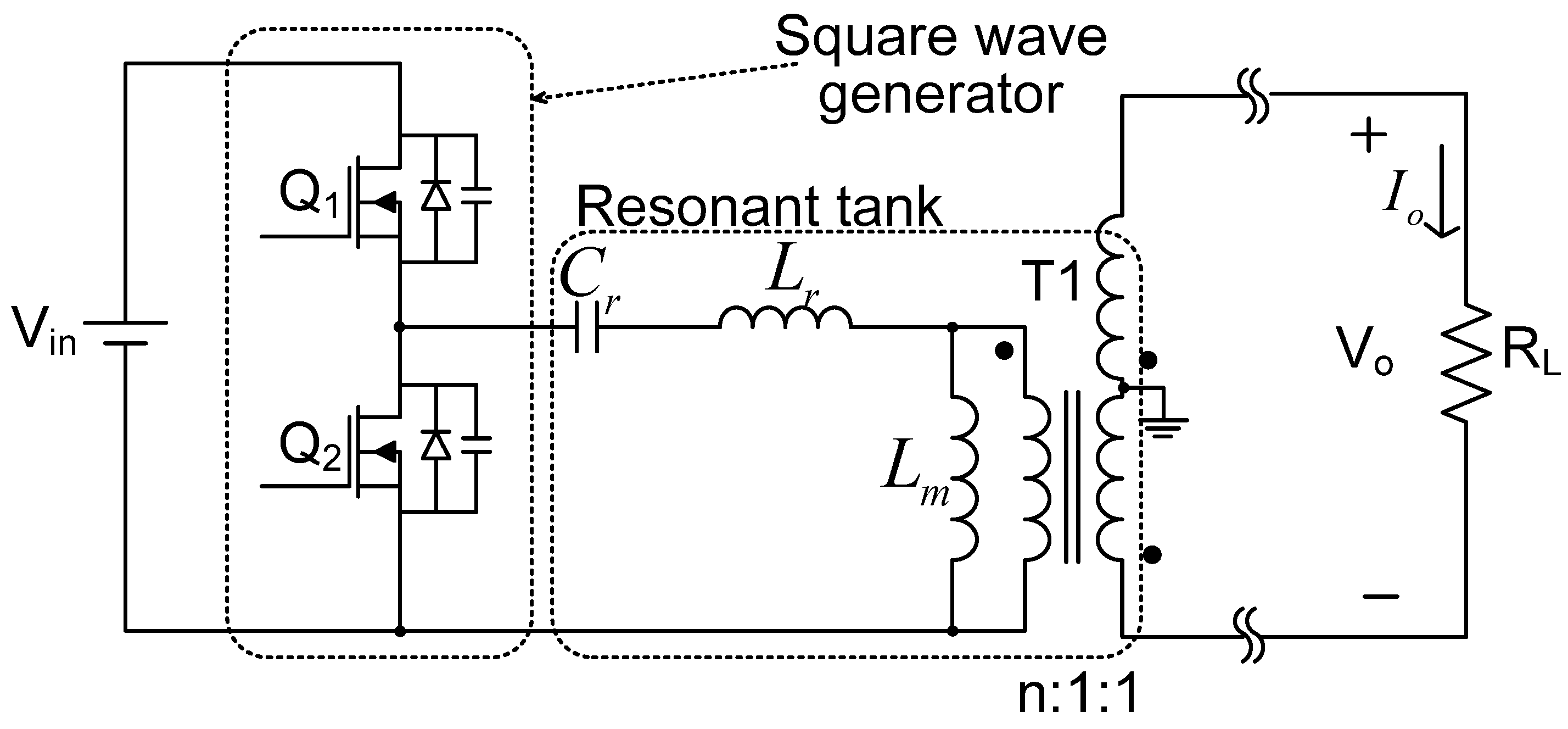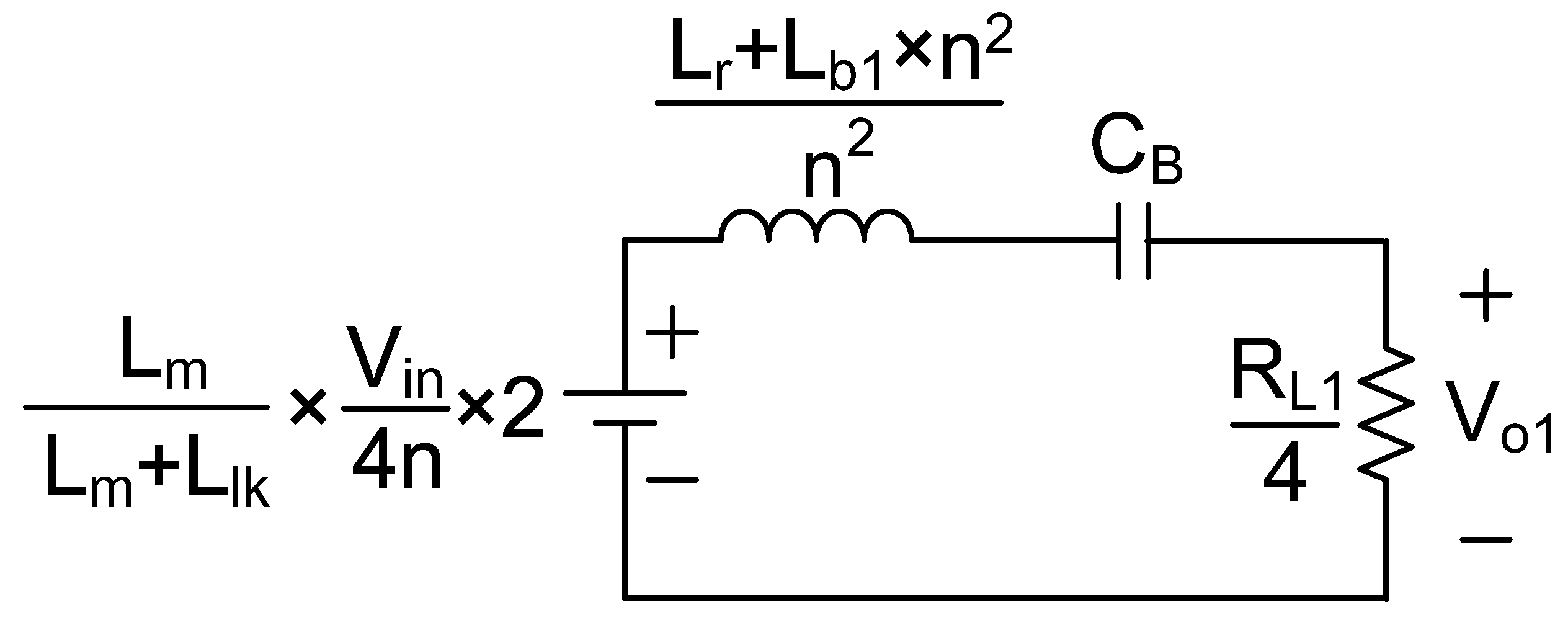Design of an LLC Resonant Converter for Driving Multiple LED Lights Using Current Balancing of Capacitor and Transformer
Abstract
:1. Introduction

2. Converter for Driving LED Lights
2.1. Conventional Converter for LED Application


2.2. Proposed Current Balancing Converter for Driving LED Lights

- BLK1
- A PFC block for achieving high power factor with wide input voltage range from 90 Vac to 264 Vac.
- BLK2
- A half bridge block makes a square wave voltage with 380 Vdc input and nearly 50% duty ratio. The block has a short dead time to ensure continuous current flow.
- BLK3
- A resonant tank block consisting of a capacitor and magnetizing inductance of transformer . The resonance tank operates with high frequency and creates a sinusoidal current from the square wave voltage from BLK2. Since the primary current is delayed by resonance, MOSFET is turned on with the ZVS condition.
- BLK4
- A resistor of this block is used for LED current sensing and limiting. A regulated DC voltage is applied to an LED load through () and (). () and () are connected parallel to the LED load and the DC voltage is made smooth. The larger capacitance can further reduce AC noise.















3. Experimental Results
| Component | Part | Description |
|---|---|---|
| Drive IC | PFC | SCY99102 (Onsemi) |
| LLC | L6599 (STmicro) | |
| MOSFET | , | STF13NM60 (STmicro) 600 V/13 A |
| Transformer | EPC3842 (Crova Hiteck) 51T:35T:35T (650 μH:350 μH:350 μH) Lr = 220 μH | |
| EE2020 (Crova Hiteck) 100T:100T (3 mH:3 mH) | ||
| Capacitor | Flim-Cap 10 nF/630 V (Pilkor) × 2 EA (20 nF) | |
| Flim-Cap 22 nF/630 V (Pilkor) | ||
| , | Ceramic-Cap 1 μF/100 V (Murata) × 2 EA serial (2 μF) | |
| Diode | , | STTH8T06 (STmicro) 600 V/8 A |
| Component | Part | Conventional Converter | Proposed Converter |
|---|---|---|---|
| IC | PFC, LLC | 2 EA | 2 EA |
| Buck | 4 EA | 0 EA | |
| MOSFET | , | 2 EA | 2 EA |
| Buck | 4 EA | 0 EA | |
| Transformer | 1 EA | 1 EA | |
| 0 EA | 2 EA | ||
| Inductor | Buck | 4 EA | 0 EA |
| Capacitor | , | 1EA (CB 0 EA) | 2 EA |
| E-Cap | 5 EA | 0 EA | |
| Diode | LLC | 2 EA | 0 EA |
| Buck | 4 EA | 0 EA | |
| Proposed | 0 EA | 4 EA | |
| Total | 29 EA | 13 EA | |







4. Conclusions
Author Contributions
Nomenclature
resonant frequency and minimum resonant frequency | |
primary and secondary side inductance of the balanced transformer
| |
leakage inductance of primary side
| |
magnetization inductance of transformer
| |
primary side inductance of transformer
| |
inductance and capacitance of resonant tank | |
| Av | transfer gain of equivalent tank circuit |
transformer turn ratio | |
number of turns in the primary and secondary coils respectively | |
quality factor of equivalent tank circuit | |
an equivalent resistive value of the LED | |
load resistance of equivalent circuit | |
an equivalent resistive value of the
and
| |
voltage and current of capacitor
| |
voltage of diode
, | |
voltage of
, | |
output voltage and current and power of equivalent circuit | |
load voltage and current and resistance of equivalent circuit (fundamental approximation) | |
voltage across the secondary side of transformer
| |
primary and secondary side voltage of transformer
|
Conflicts of Interest
References
- Tan, Y.K.; Huynh, T.P.; Wang, Z. Smart personal sensor network control for energy saving in DC grid powered LED lighting system. IEEE Trans. Smart Grid 2013, 4, 669–676. [Google Scholar] [CrossRef]
- Lv, X.; Loo, K.H.; Lai, Y.M.; Tse, C.K. Energy-saving driver design for full-color large-area LED display panel systems. IEEE Trans. Ind. Electron. 2014, 61, 4665–4673. [Google Scholar] [CrossRef]
- Hui, S.Y.R.; Chen, H.; Tao, X. An extended photoelectrothermal theory for LED systems: A tutorial from device characteristic to system design for general lighting. IEEE Trans. Power Electron. 2012, 27, 4571–4583. [Google Scholar] [CrossRef]
- Zhang, J.; Xu, L.; Wu, X.; Qian, Z. A precise passive current balancing method for multioutput LED drivers. IEEE Trans. Power Electron. 2011, 26, 2149–2159. [Google Scholar] [CrossRef]
- Zhao, C.; Xie, X.; Liu, S. Multioutput LED drivers with precise passive current balancing. IEEE Trans. Power Electron. 2013, 28, 1438–1448. [Google Scholar] [CrossRef]
- Lin, R.L.; Chang, Y.C.; Lee, C.C. Optimal design of LED array for single-loop CCM buck-boost LED driver. IEEE Trans. Ind. Appl. 2013, 49, 761–768. [Google Scholar] [CrossRef]
- Kim, M.G. Error amplifier design of Peak Current Controlled (PCC) buck LED driver. IEEE Trans. Power Electron. 2014, 29, 6789–6795. [Google Scholar] [CrossRef]
- Zhang, F.; Ni, J.; Yu, Y. High power factor AC-DC LED driver with film capacitors. IEEE Trans. Power Electron. 2013, 28, 4831–4840. [Google Scholar] [CrossRef]
- Lee, A.T.L.; Sin, J.K.O.; Chan, P.C.H. Scalability of quasi-hysteretic fsm-based digitally controlled single-inductor dual-string buck LED driver to multiple strings. IEEE Trans. Power Electron. 2014, 29, 501–513. [Google Scholar] [CrossRef]
- Zhang, R.; Chung, H.S.H. Transformer-isolated resonant driver for parallel strings with robust balancing and stabilization of individual LED current. IEEE Trans. Power Electron. 2014, 29, 3694–3708. [Google Scholar] [CrossRef]
- Hasan, J.; Ang, S.S. A high-efficiency digitally controlled RGB driver for LED pixels. IEEE Trans. Ind. Appl. 2011, 47, 2422–2429. [Google Scholar] [CrossRef]
- Lo, Y.K.; Wu, K.H.; Pai, K.J.; Chiu, H.J. Design and implementation of RGB LED drivers for LCD backlight modules. IEEE Trans. Ind. Electron. 2009, 56, 4862–4871. [Google Scholar] [CrossRef]
- Ng, S.K.; Loo, K.H.; Lai, Y.M.; Tse, C.K. Color control system for RGB LED with application to light sources suffering from prolonged aging. IEEE Trans. Ind. Electron. 2014, 61, 1788–1798. [Google Scholar] [CrossRef]
- Feng, W.; Lee, F.C.; Mattavelli, P. Optimal trajectory control of LLC resonant converters for LED PWM dimming. IEEE Trans. Power Electron. 2014, 29, 979–987. [Google Scholar] [CrossRef]
- Hong, S.W.; Kim, H.J.; Park, J.S.; Gun, Y. Secondary-side LLC resonant controller IC with dynamic PWM dimming and dual-slope clock generator for LED backlight units. IEEE Trans. Power Electron. 2011, 26, 3410–3422. [Google Scholar] [CrossRef]
- Cheng, C.A.; Cheng, H.L.; Chung, T.Y. A novel single-stage high-power-factor LED street-lighting driver with coupled inductors. IEEE Trans. Ind. Appl. 2014, 50, 3037–3045. [Google Scholar] [CrossRef]
- Wu, X.; Zhang, J.; Qian, Z. A simple two-channel LED driver with automatic precise current sharing. IEEE Trans. Ind. Electron. 2011, 58, 4783–4788. [Google Scholar] [CrossRef]
- Kim, J.K.; Lee, J.B.; Moon, G.W. Isolated switch-mode current regulator with integrated two boost LED drivers. IEEE Trans. Ind. Electron. 2014, 61, 4649–4653. [Google Scholar] [CrossRef]
© 2015 by the authors; licensee MDPI, Basel, Switzerland. This article is an open access article distributed under the terms and conditions of the Creative Commons Attribution license (http://creativecommons.org/licenses/by/4.0/).
Share and Cite
Han, J.-H.; Lim, Y.-C. Design of an LLC Resonant Converter for Driving Multiple LED Lights Using Current Balancing of Capacitor and Transformer. Energies 2015, 8, 2125-2144. https://doi.org/10.3390/en8032125
Han J-H, Lim Y-C. Design of an LLC Resonant Converter for Driving Multiple LED Lights Using Current Balancing of Capacitor and Transformer. Energies. 2015; 8(3):2125-2144. https://doi.org/10.3390/en8032125
Chicago/Turabian StyleHan, Jae-Hyun, and Young-Cheol Lim. 2015. "Design of an LLC Resonant Converter for Driving Multiple LED Lights Using Current Balancing of Capacitor and Transformer" Energies 8, no. 3: 2125-2144. https://doi.org/10.3390/en8032125
APA StyleHan, J.-H., & Lim, Y.-C. (2015). Design of an LLC Resonant Converter for Driving Multiple LED Lights Using Current Balancing of Capacitor and Transformer. Energies, 8(3), 2125-2144. https://doi.org/10.3390/en8032125





